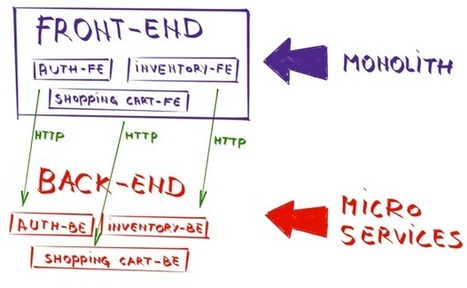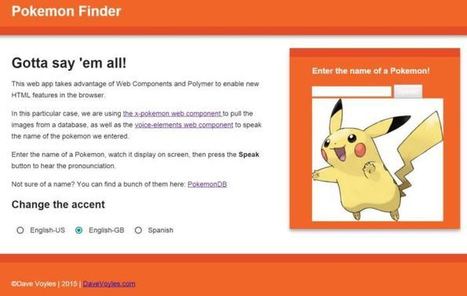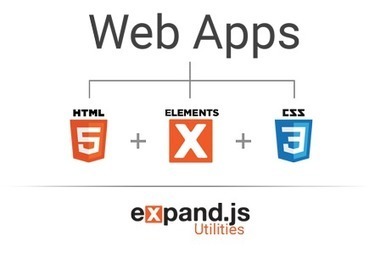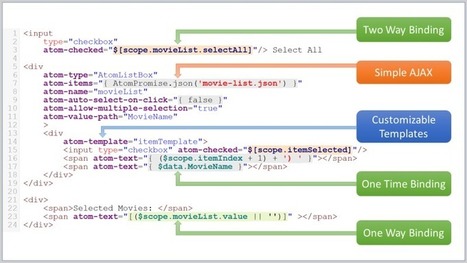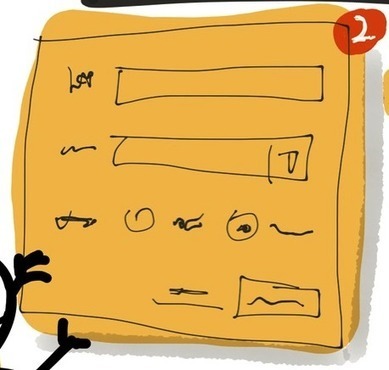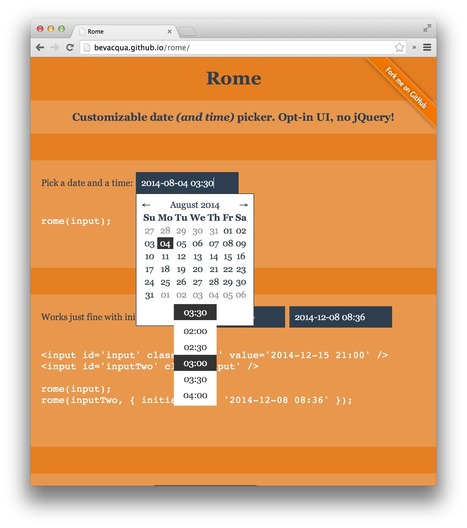In 'Totally Tooling Tips' web developers Matt and Addy discuss the latest topics, issues and work arounds for building apps and libraries to help mop up your Totally Tooling Tears.
Get Started for FREE
Sign up with Facebook Sign up with X
I don't have a Facebook or a X account



 Your new post is loading... Your new post is loading...
 Your new post is loading... Your new post is loading...
Current selected tag: 'WebComponents'. Clear
No comment yet.
Sign up to comment
From
medium
Many of you have probably heard of Facebook’s React library and used it in your own work or projects. It’s extremely pop…
In this project I want to compare the usage and development of components in several frameworks. To test these frameworks I'll create multiple components from simple to complex to show the differences between these frameworks. I currently plan to look into the following frameworks: Microservices are becoming more and more popular and many are choosing to transition away from monolithic architecture. However, this approach was mostly limited to back-end services. While it made a lot of sense to split them into smaller independent pieces that can be accessed only through their APIs, same did not apply to front-end. Why is that? I think that the answer lies in technologies we’re using. The way we are developing front-end is not designed to be split into smaller pieces. Server-side rendering is becoming history. While enterprise might not agree with that statement and continues pushing for server-side frameworks that “magically” transform, for example, Java objects to HTML and JavaScript, client frameworks will continue to increase in popularity slowly sending server-side page rendering into oblivion. That leaves us with client-side frameworks. Single-Page Applications are what we tend to use today. AngularJS, React, ExtJS, ember.js and others proved to be a next step in evolution of front-end development. However, Single-Page Applications or not, most of them are promoting monolithic approach to front-end architecture.
Jan Hesse's insight:
follow up:
Creating my own component I wanted to design something simple, so I created a container to hold three radial buttons; one button for each language selection. Users now have the ability to select a radial button associated with a language (en-EN, en-GB, and es-ES), which would in turn be tied into the audio web component and change Essence is a CSS framework that implements the guidelines from Google Material Design Specification using Facebook's react.js library. Use it to easily build super-fast and great looking web & mobile interfaces.
Jan Hesse's insight:
ExpandJS is a library containing 80+ custom elements and 350+ utility functions to kickstart your Web Applications. The elements follow Google's Material Design guidelines, allowing for beautiful and responsive interfaces. ExpandJS is built upon the latest web standards, leading to rapid development, reusability and high maintainability.
From
github
AtomsPreCompiler compiles atoms markup into valid HTML5 by breaking up inline expressions into generated JavaScript. This pre-compiled document runs in strict mode without using eval without compromising speed.
Jan Hesse's insight:
Strand is a growing library of common UI widgets built as web components. Strand components are cohesive in look and feel and designed to be interoperable. We've built Strand atop Google's Polymer framework.
From
ele
Ele (call it “Ellie”) is a streamlined environment for exploring, experimenting with, and sharing reusable custom HTML elements made with Web Components. Mike covers the road to native web components (learn what you can do today with this technology), whereas Jay reveals the solutions he’s working on and discusses the coveted universal web component format.
Stef finishes off by covering the history, state, and plan of web components in ember.js.
What we'll cover
|
From
frend
Frend components are modest and dependency-free. They are built with web standards as a priority and aim to avoid assumptions about tooling or environment. Care has been taken to make sure each component is compliant, keyboard navigable and properly interpreted by assistive technologies. The purpose of Frend is to offer ready-to-use components for projects. These also provide specifics on how they’ve utilised ARIA attributes and event bindings, based on global recommendations, in order to make them more predictable and usable for all. The goal is to work on these components collaboratively. This allows us to share our implementation experiences, approaches to supporting different environments, and any bugs we’ve come across along the way. Iframes… Can’t live with them, can’t live without them. Is it just me or anyone else is also wondering why these guys are still being used even though the 90s are long gone? Well, believe it or not - no one has come up with a better alternative for embedding another HTML document into your page since Microsoft first introduced the tag in 1997. Not until recently, at least. Most modern front-end JavaScript frameworks provide some sort of support for component based development. This is an incredibly important step in the direction of development for the web. Components provide a way to write small parts with a consistent API that can easily be orchestrated as part of a larger screen, application or system. Component based development isn’t just the future of the web, though. It’s what you should be doing now, in any modern UI / application framework on the web. A intro to the new web component spec by building a simple tab component. One of the main issues in our components today are style conflicts. This is when our CSS or the imported component breaks CSS somewhere else. Another is lack of native templating of HTML. Storing HTML templates on a page have only been possible by using script tags or other hacks. The current component structures lack of semantic meaning. We end up with a big pile of div's that have little meaning. Angular has tried to help this with its custom element directives. The new HTML5 Web Component Specification is a collection of specifications that when combined create a powerful web standard for creating reusable components. Skate is a web component library that is focused on being a tiny, performant, syntactic-sugar for binding behaviour to custom and existing elements without ever having to worry about when your element is inserted into the DOM. It uses the Custom Element spec as a guideline and adds some features on top of it. There are some things to consider when building a web component that aren't quite obvious at first. Things like having compound components; ones that have parents and children that are all components and are supposed to interact with each other. There's also some gotcha's when working with polyfilled components vs native web components.
From
github
Maple.js is a contemporary React based framework mixing ES6 with Custom Elements, HTML Imports and Shadow DOM. It has in-built support for SASS and JSX, including a Gulp task for vulcanizing your project. Maple is a seamless module that allows you to organise your React project in terms of webcomponents — with HTML Imports, Shadow DOM, and Custom Elements — allowing you to implement any Flux architecture you choose, and then compile with Mapleify for production. By now, you may have heard a lot of things about Web Components. Some people say it's the promise land, others say it has been oversold. Although they're not going to solve all your life's problems, they do provide a paradigm shift from the traditional approach of web development. If you still aren't sure about what exactly is Web Components or even why you should care about it, this session is for you. In this session Dmitry goes through a brief overview of the Web Component specifications and how they fit in to application development today. The talk also covers best practices available to developers to use with Web Components.
From
ponyfoo
In my experience, I've found that the best pieces of code I've ever used tend to follow the UNIX philosophy of doing one thing very well. Having that kind of focused approach to front-end modules typically isn't the case. Instead, we often develop solutions that are only useful in our specific use. For example, we may put together an entrenched AngularJS directive that uses other directives or relies on data-binding provided by Angular. What's worse, most often we don't just limit ourselves to the scope of the libraries we're currently using, but to the specific scope of the one project we're working on. This means that now our library can't be extricated from that database without considerable work. So we will try to stay focused on one particular topic: componentization and discuss some of the philosophy and ideas that various frameworks and libraries exhibit in this particular area, but which are unfortunately still quite often lost behind the intricate technical details of the APIs they expose or are not emphasized enough and underutilized by developers. For example, I saw at least a few Angular projects that did not reuse as much code as they could have just because for some reason they avoided using custom directives (a bit later we will discuss how those relate to Web Components). After reading this article hopefully you will have a better grasp of the subject and also understand that despite superficial differences between APIs some common principles behind are still quite similar. Contents:
Expanding our Aurelia Reddit client, Aurelia core team member, Vildan Softic, demonstrates how to extend HTML by leveraging custom elements and attributes. So why would you want to put a Web Component in an app built with one of these frameworks? Web Components let you create elements that apps can interface with in the same way that they already interface with native elements. That means that a Web Component can be reused anywhere, in any framework. That’s the theory, at least. Let’s try it out. We’ll just be looking at Custom Elements, the heart of Web Components. This article is a brief overview of both Web Components and Ember Components as well as a comparison of the two. You will see examples of blurring the lines between native Web Components and Ember components. With the Ember 2.X Evolution under way, you will have a new generation of first class citizens for your DOM, Ember.Components. Perhaps this overview will help you to design your Ember Components with future standards in mind, learn how to use native Web Components in synchronicity with Ember Components, and learn how to upgrade a native Web Component to an Ember.Component. |




